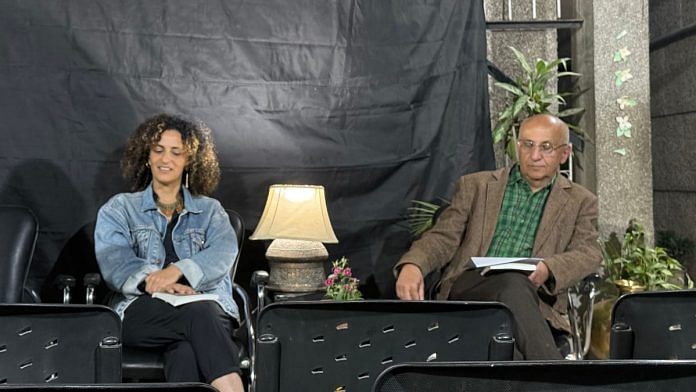New Delhi: The screen flickered to life. The first image was Mahsa Amini, the 22-year-old Kurdish-Iranian woman who died in police custody in Tehran and became a global symbol of defiance. Flicker. Women ripped off their hijabs. Flicker. The street thrummed with chants of ‘jin, jiyan, azadi! (woman, life, freedom!)’. And then the police came with batons. The audience gasped.
In the calm embrace of a crisp New Delhi evening, a small courtyard at the Centre for Equity Studies came to life under the glow of the projector screen. This was more than just a discussion on Chowra Makaremi’s new book, Woman! Life! Freedom!: Echoes of a Revolutionary Uprising in Iran. Anthropologist and researcher Makaremi, whose mother and aunt were jailed and executed in the 1988 prison massacre in Iran, led the audience into the heart of the ongoing fight for justice and liberation in the country.
The conversation, held on 1 February, was led by author and researcher Harsh Mander who was joined by academics and researchers.
Originally written in French and translated by Maya Judd, Makaremi’s Femme! Vie! Liberté! is like a journal. She documents the events of the 2022 uprising in Iran that was sparked following the death of Mahsa Amini. She died on 16 September 2022 in a hospital after her arrest by the country’s morality police for not wearing her hijab to the liking of the authorities.
“It was the nervous system of resistance,” said Makaremi. “Because what truly enabled these uprisings wasn’t just the death of one person—it’s the moment when that death becomes the breaking point.”
Makaremi also drew parallels to the pivotal deaths of Mohamed Bouazizi in Tunisia, George Floyd in the US, and Nahel Merzouk in France. According to her, Amini’s death became the breaking point for a nation burdened by systemic violence.
“These resistance movements, though minor and repressed, have kept open the pathways for revolt,” she said.
While talking about the funeral of Mahsa Amini, Makaremi highlighted how Kurdistan became the epicentre of revolts, where networks forged since the Iranian revolution of 1979—women’s unions, Kurdish resistance movements, and educators—orchestrated acts of civil disobedience.
She emphasised how these resistance networks, though often repressed, function like a “synaptic system”—dormant, but ready to be reignited when the moment demands.
This enduring system, Makaremi argued, fuels Iran’s evolving “language of revolt”. It’s the grammar of courage and joy that declares: “We are not afraid.”
‘Burning the veil’
Discussing the 2022 uprising in Iran, Mander drew parallels with India’s freedom struggle. He noted that while deeply religious figures like MK Gandhi and Maulana Azad fought for inclusivity, secular figures such as VD Savarkar and Mohammad Ali Jinnah were advocating for religious states. Mander then posed a question to Marakemi: was the Iranian uprising a battle against faith or a protest against the misuse of religion for power?
Makaremi, an anthropologist and researcher at the French National Centre for Scientific Research (CNRS), contextualised the protests within Iran’s rich yet often misunderstood history since the 1979 Islamic Revolution.
In response to Harsh Mander’s question, Makaremi made a compelling case.
She agreed with Mander’s comparison, but clarified that the protests in Iran are not about rejecting faith but resisting its weaponisation by a theocratic regime. She noted that her mother, a student activist in Iran along with her sister, was executed after seven years in captivity.
Makaremi explained that Iranian feminists initially prioritised legal and economic equality over the veil, agreeing to wear it if it meant gaining rights.
“They wanted equality in job opportunities, inheritance, and legal testimony—not just a symbolic liberation,” she said. By 2017, however, they realised the system was irreformable, and radicalised their approach, making the veil central to resistance.
“In Iran, burning the veil is not about rejecting veiled women,” Makaremi added.
Also read: Painter Ghulam Mohammad Sheikh lived on Rs 50 as student. His father pushed him to study
Beyond tales of liberation
Woman! Life! Freedom! challenges what Makaremi calls “patronising Western narratives” that frame the Iranian feminist movement as a recent awakening.
“Iranian women and men have been awake for a very long time,” she said.
She was critical of the Western media for fixating on the hijab, often at the cost of missing the core of the protests in Iran, and perpetuating a narrative of newfound empowerment.
“One common misconception is the portrayal of Iranian society as backward, religious, and conservative—passively conforming to or accepting the often absurd, always misogynistic, patriarchal, and authoritarian rules of the theocratic state,” Makaremi told ThePrint, adding that “this is not the case”.
“The general mentality of the Iranian public is far removed from the rules, ideologies, and discourses of the state. Taking off the veil was a political act in public, but in private, it had not been an issue for a long time.”
Makaremi’s book, instead of following the familiar Western storytelling path, engages in conversations that resist power structures shaping global narratives.
“It finds an audience beyond the imposed tales of liberation,” she said.
Also read: History of 1921 Malabar revolt is being decolonised. British reduced it to Hindu-Muslim clash
‘Identity’
What makes Mahsa Amini’s death all the more relevant is that she was Kurdish.
Amini was targeted not just for being a woman but also because of her Kurdish identity, which made her and her brother “foreigners” in the city, said Makaremi.
During the conversation, Mander read a haunting poem, once recited at Mahsa Amini’s grave by a Kurdish poet.
“Don’t close your eyes, you and your eyes.
Don’t send me hopelessly away from your heart.
Don’t leave me alone—I too am an exile, a stranger in this city.”
(Edited by Aamaan Alam Khan)






